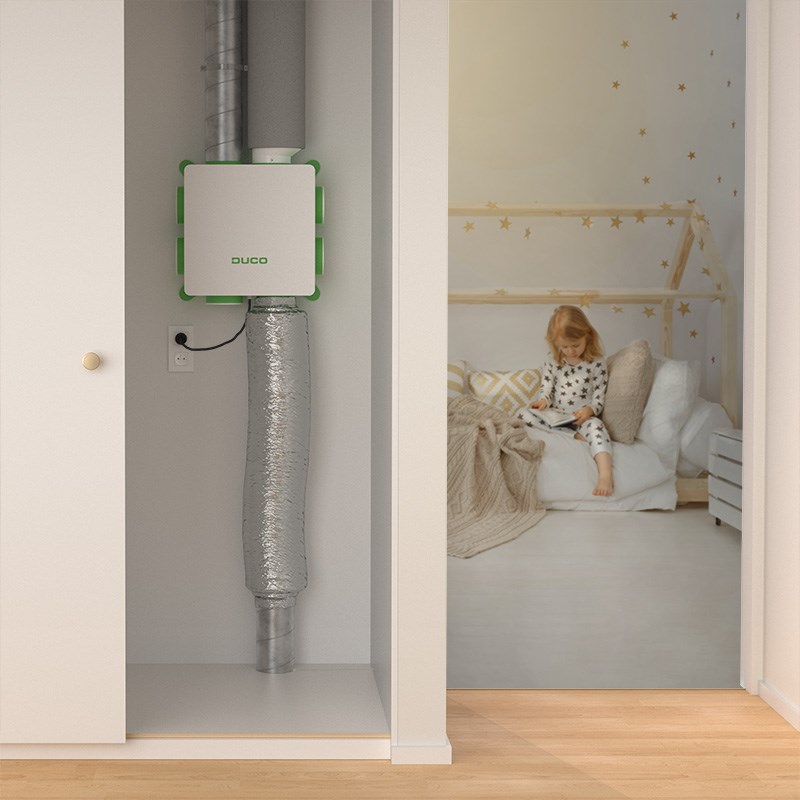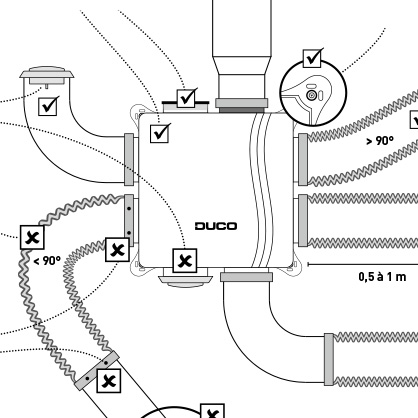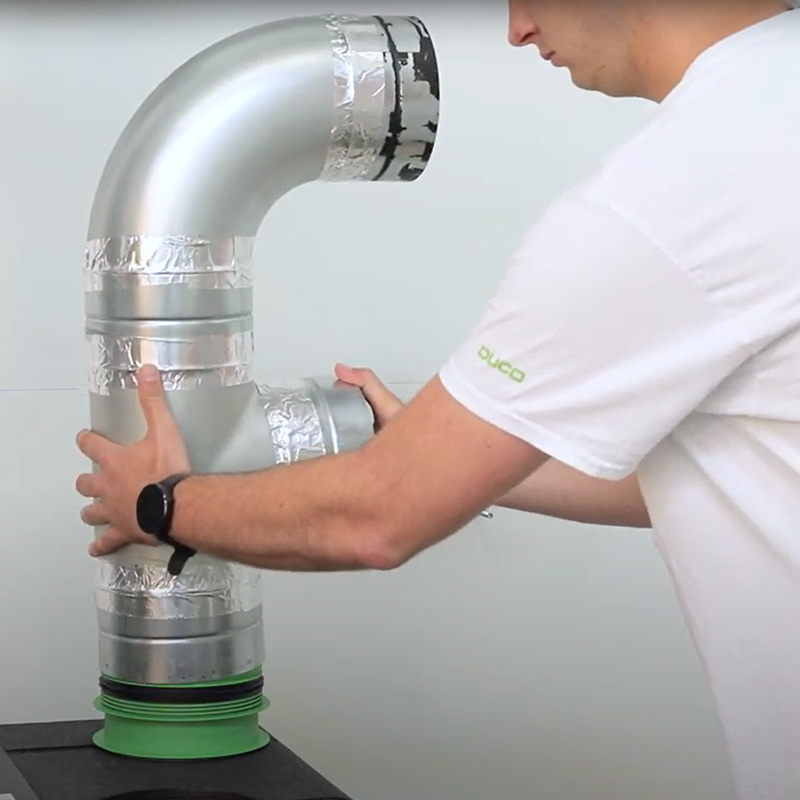Noise pollution from your ventilation system? Here's how to prevent it!

How do you ensure that the ventilation system operates as quietly as possible? The installation and location of the ventilation box and air ducting system is more important than you think! Fortunately, these tips and DUCO tools will help prevent noise pollution from MEV and MVHR systems.
Noise prevention starts with installation
If you want an installation that operates quietly, you obviously need a ventilation unit that is inherently designed to be quiet. In addition, the installation and adjustment of the unit and all associated components also plays an important role.
It all starts with the choice of materials and components, a well-thought-out laying plan and the correct installation of the entire ventilation system. Fortunately, there are various tools and services available to help you do just that.
Duct diameter
One of the biggest culprits in terms of noise is the diameter of the ducts. The greater the air flow rate that needs to pass through the ducts, the larger that diameter should actually be.
If the diameter is too small then the air resistance will be much too high in the duct. As a result, the unit will have to work longer and harder to remove polluted air from the home. Many residents then choose to turn the ventilation system off, but this is obviously not a good idea.
- MEV: ø 125 mm from 30 m3/h / Ø 100 mm less than 30 m3/h / Ø 160 mm to roof outlet
- MVHR: ø 160 mm up to 250 m3/h / Ø 180 mm from 250 m3/h
Types of ducts
Besides the diameter of the duct, the type of duct is also a determining factor. Avoid using flexible ducts wherever possible. Rigid ducts with a flat interior allow air to be transported as smoothly as possible through the ducts. Flexible ducts create vortices in the moving air, which does not improve the operation of the unit.
- Use rigid ducts as much as possible
- Avoid a flexible duct for the duct to the roof penetration
Location of ducts
As a final aspect of the duct system, consideration should be given to its mounting. Although the options here are sometimes limited, it is still important to make as few bends as possible. Certainly the closer the bend is to the ventilation device itself, the more impact it has on operation.
- Avoid bends as much as possible
- Never make bends sharper than 90°
Silencers
If the first three points have been followed as best as possible and there is still a concern that noise pollution may occur, then silencers may offer a solution. You install these components at the loudest points of the installation to absorb some of the noise production there.
- MEV: install an acoustic damper of 0.5m to 1m per duct port leading to another room
- MVHR: install an acoustic damper of 1m per duct towards the house
Adjustment of air flow rates
Last but not least, the correct adjustment of the ventilation system. The air-side control of the ventilation device can make or break an installation. There should not be too little ventilation, but too much ventilation causes noise problems. Preferably, ventilation is also only provided where and when it is needed (demand-controlled or zonal ventilation).
- Make sure the ducts are attached airtight, so there are no leakage losses
- Select a roof pass-through with low resistance
1. Material requirement
Every installation starts with proper preparation. And that's where DUCO can help. On request, we map out the material requirements for ventilation systems with ventilation ducts, boxes, fittings,... And all with gross prices so you get an idea of the cost immediately. This includes a clear and detailed drawing of all ventilation ducts in the house.
Provide us with the necessary information such as the building plans, EPB dossier and/or ventilation preliminary design and we will send you back an indicative material requirement, always tailored to the project.
- Contact us for a material requirement and laying plan
2. Installation tips for mechanical ventilation
Each ventilation duct, damper and connector must be properly positioned to ensure correct operation of the ventilation device. For this reason, we supply every DucoBox with a leaflet that lists the most important tips for proper installation and ductwork.
In addition, each box also gets a unique QR code that leads to a help page with all the instructions and information about that device. Handy when you are at a standstill on site!
- Download the installation tips for DucoBox Silent / Focus
- Download the installation tips for the DucoBox Energy Comfort / Premium

3. Technical instruction videos
In addition to installation tips and manuals on paper or in PDF form, installation videos are also available on duco.tv. In these short videos, we show you step-by-step how to install a DUCO ventilation system or replace its parts and accessories.

4. Duco Installation App
Couple your knowledge with the use of the new Duco Installation App, which guides you step by step through the installation process and also delivers a ready-made ventilation report. This saves time per project and wipes out a whole chunk of administration.
In addition, you can read error messages and immediately send a fault report to DUCO to receive prompt feedback.
All benefits at a glance:
- Calibrate the DucoBox ventilation system quickly and easily (handy installation wizard)
- Read out and change parameters and generate an intervention report
- Read out error messages
- Generate universal ventilation report
- Add photos of the installation
- Download documentation
- Carry out software updates
The Duco Installation App can only be used by using the Duco Installation Kit.
- Download the DUCO Installation App for free in the App Store or on Google Play.
- Order a Duco Installation Kit in the webshop
5. Technical advice
Need general advice or some pressing questions you can't immediately find the answer to?
Then be sure to get in touch with our technical advisers. By phone, or on site, a DUCO staff member is always available to help further the matter.
After installation comes maintenance
By following these tips, you can greatly reduce noise pollution from mechanical ventilation. But disturbing noises may still occur over time. An accumulation of dust and dirt, for example, can affect the ventilation unit’s operation. This not only has a negative effect on the indoor air quality, but will also affect acoustic comfort.
DUCO's maintenance instructions provide the ideal guide to schedule the necessary servicing. Keep the installation clean and cared for so you can enjoy a continuously healthy indoor environment without noise pollution.
- Download maintenance instructions of mechanical ventilation systems
- Watch the instruction videos mechanical ventilation maintenance